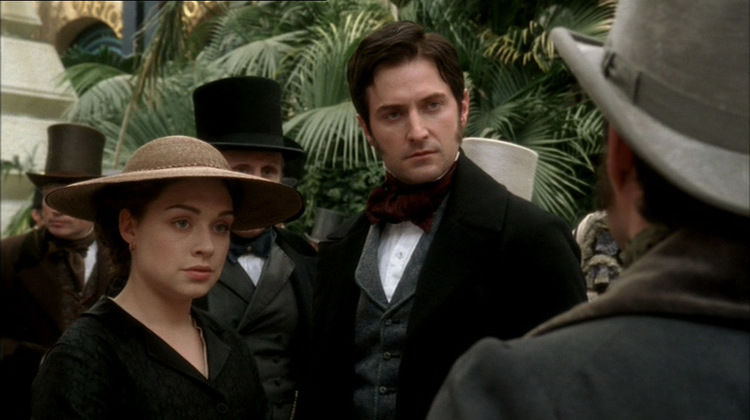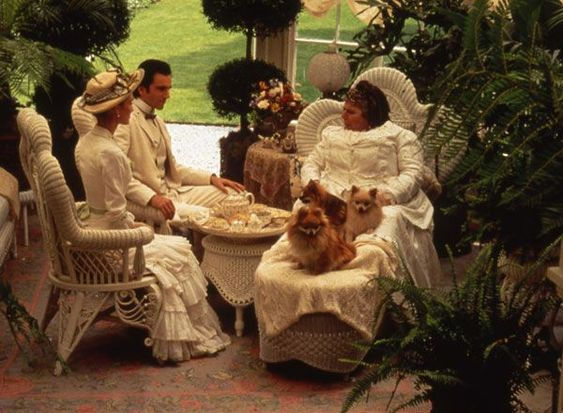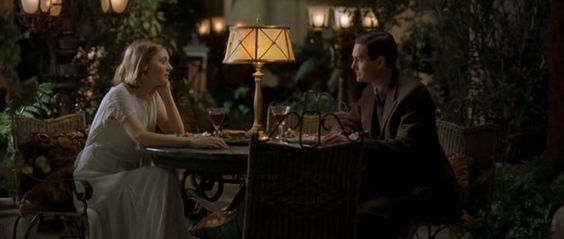Transcending Glass - The Greenhouse Effect on Page and Screen
- robyncoombes
- Jan 31, 2023
- 8 min read
Updated: Apr 1, 2023

Fig. 1. The Giant Water Lily at Chatsworth ‘supporting’ Paxton’s daughter – “on exhibit like a diminutive fairy on a toadstool in the wonderland of the conservatory” (Armstrong 174). Illustrated London News, 17 Nov. 1849.
The giant water lily pictured above could almost be an illustration from Alice in Wonderland or The Water Babies, but instead depicts Joseph Paxton’s famous horticultural feat in the Illustrated London News. Brought to Chatsworth House after its failed term at Kew Gardens, the Victoria Regia, aka Paxton’s giant lily pad, managed to flower under the careful cultivation of Chatsworth’s head gardener, (Paxton) in 1849. Kept in one of the many glasshouses of the Duke of Devonshire’s humble abode, the lily leaf measured a whopping 11 feet round and supported Paxton’s own 7-year old daughter (with the assistance of an underwater support (Armstrong 173-4)). Interestingly, the plant prompted Paxton to design a glasshouse worthy (and large enough) for its public display (Rainsford 475). Thus the Crystal Palace was born, which would famously house the Great Exhibition of 1851.

Fig. 2. Still from North and South, directed by Brian Percival, BBC, 2004. This scene takes place at the Great Exhibition in Crystal Palace, (which does not occur in Gaskell’s novel).
If you too have watched your fair share of period dramas, you might have noticed the prevalence of the greenhouse in depictions of 19th and 20th century high society. Though transparent, these spaces often function as the site of secret trysts, coy flirtations, or even indecent proposals, while providing the perfect backdrop for the costume drama’s love for lavish detail. Picture the scene – a dazzling feat of glazing (bear with me) sparkles with evening candlelight, as an opera-gloved lady sips daintily from her crystal goblet and coyly avoids the male gaze loitering behind the palm fronds.

Fig. 3. Still from The Age of Innocence, directed by Martin Scorsese, Cappa Productions, 1993. May and Newland enjoy a private moment in the conservatory before their engagement is made public.
For some reason I’ve been fascinated by the role the glasshouse/conservatory, greenhouse/hothouse plays in both literature and screen depictions of the Romantic, Victorian, and Edwardian eras. Their decadence reads like a condensed pastoral idyll or preserved Eden - saturated colours and textures, gargantuan leaves and sumptuous flowers to hide behind (at least that’s my idea of Eden). The vines, roses, and ‘cottage-core’ creepers of the costume drama’s glasshouses make these cluttered spaces almost oppressively picturesque. But I’ve been wondering if there is more to the greenhouse, and why this space so often occurs in scenes of transgression and excess?

Fig. 4. Still from The Age of Innocence, directed by Martin Scorsese, Cappa Productions, 1993. You can almost get a headache from the stifling amount of flowers in every frame of Scorsese’s film. Mrs Manson Mingott’s conservatory is no exception to the claustrophobic aesthetic.
From Austen to Gaskell, and Wharton to Waugh, many authors seem to criticise the hothouse against the more ‘natural’ garden, framing the former as a contrived space of artificiality. Even though gardens of the time were also highly orchestrated, maintained environments, concerns focus less on human intervention in nature than on the distinctly ‘exotic’ character of the hothouse. Take Newland Archer’s thoughts on “queer cosmopolitan women … too much like expensive and rather malodorous hot-house exotics, to detain his imagination long” (Wharton, Ch. 20). Or Gaskell’s Wives and Daughters, where the “long glittering range of greenhouses and hothouses” of Cumnor Towers “Molly did not care for … half so much as for the flowers in the open air” (15). The intoxicating perfumes and “heated atmosphere” of the hothouse almost stifle young Molly Gibson, who asks - “‘May I go back, out into the garden? I can't breathe here!’" (15). Instead she finds “liberty” in the alluring shade of a cedar tree, under which, like Alice, she falls into a disoriented sleep in its “black repose” (15).
Outside the greenhouse are the staples of any English cottage garden - familiar climbing roses and honeysuckles - but behind glass lie those “precious flowers” (15), the orchids, whose well-known association suggests a possible subtext for Molly’s discomfort. The soporific fumes instinctively alert her to the threat of impending adulthood, symbolised by the sexually-charged image of the orchid. Molly’s liminal status between girlhood and adolescence is reinforced here by the glasshouse’s amalgamation of exterior/interior. Escaping glass confinement for the garden signifies both her position as outsider and her impetus towards independence and transcendence.
The novel’s Hamley Hall also possesses “old-fashioned greenhouses” (71). Paling in comparison to the Towers’ opulent displays, their outmoded design probably shares a similar aesthetic with Fanny Dashwood’s proposed glasshouse in the earlier Sense and Sensibility. Along with a new flower-garden, the ‘green-house’ will supplant the sadly demolished “old walnut-trees” (213) at Norland Park, an improvement which provokes “concern” and “censure” (214) in the recently ousted Elinor. Perhaps she anticipates the ‘exotic’ fruits of Fanny’s greenhouse, which according to Liz Bellamy, “primarily function in the novels of the 1770s to connote corruption and extravagance, developing the condemnation of artifice rather than the praise of ingenuity" (169).

Fig. 5. Still from Mansfield Park, directed by Patricia Rozema, Miramax and BBC, 1999. The Conservatory as a luxurious auditorium for a glass-playing performance while the camera pans to an overt representation of Mansfield’s dependence on slavery.
Meanwhile in Northanger Abbey, the Tilneys can boast not only a garden “unrivalled in the kingdom”, but a whole “village of hot-houses” and a pinery which yields approximately a hundred pineapples a year (197). According to Bethan Bell:
“By the Georgian era, pineapples were starting to be cultivated in Britain.
Perhaps surprisingly, the fact that they could now be grown in situ did not
decrease the fruit's cachet, but rather enhanced it.”
Considering pineapples were so expensive as to be rented for dinner parties, the fact that the Abbey cultivates “only” one hundred a year (197), actually presents a staggering account of General Tilney’s wealth. Bell continues that the privilege of growing pineapples was enjoyed solely by the landed gentry, who needed the expensive glazed infrastructure, (heated by coal-fuelled furnaces), as well as skilled gardeners to raise these spiky investments. If they survived the threat of the stove, they still needed a few years to reach maturity, and that handsome price tag of 60 Regency pounds, or around (£)11,000 in today’s money (Bell).

Fig. 6. Still from Emma, directed by Autumn de Wilde, Perfect World Pictures, 2020. Each mise en scène, greenhouse not excluded, displays Emma’s wealth and privilege.
Teeming with a profusion of tropical or Mediterranean species of Otherness, these transparent forcing houses both flaunted the spoils of empire and taunted with microcosms of the barely controllable. As Dominic Rainsford asserts in a review of The Hothouse Flower: Nurturing Women in the Victorian Conservatory, “the imperial commodity could cross the glass membrane and become a disruptive force”. The threat of the Other was reified in these exoticised displays, which Margaret Flanders Darby asserts, could become viable and invasive species if allowed to escape their glass containment (32).
The glasshouse certainly made an ‘artform’ of what Armstrong calls “horticultural imperialism” (167), presenting an anxious display of hybridity in unfamiliar, overgrown plants that threatened ontological categories. Somewhere in the conservatory, “a grotesque body lurked” (167). Much like Kingsley’s Water Babies, the grotesque betrayed a Victorian fear of cultural dilution, as Kingsley warned against the vegetal Irish. Don’t forget, “when people live on poor vegetables instead of roast beef and plum-pudding, their jaws grow large, and their lips grow coarse, like the poor Paddies who eat potatoes” (Kingsley 149). Thanks Charles, I’ll bear that in mind.
As the glasshouse craze developed, certain ‘innovators’ took artistic and scientific conceptualism a little far. As Isobel Armstrong states, John Claudius Loudon (renowned Victorian botanist, landscape gardener and coiner of ‘arboretum’) “had no qualms about displaying human beings in a living ‘museum’ of plants – ‘human species from the different countries imitated, habited in their peculiar costumes, and who may serve as gardeners or curators of the different productions’” (186). Luckily the only peculiar costumes and artificial dioramas nowadays belong to the world of period dramas, safe behind the glass preference of our own age.
Elsewhere, what I suspected to be a trope of greenhouses on screen – their function as a site of excess, sensuality or transgression - is the starting point for Jane Desmarais’s Monsters Under Glass: A Cultural History of Hothouse Flowers from 1850 to the Present. Desmarais acknowledges the proliferation of "amatory and often clandestine encounters" (128) depicted within the glasshouse/greenhouse/conservatory, while exploring the exoticisation of hothouse flowers and the phenomenon of the "fleur fatale". According to Mary Bowden’s review of the book, this flower power woman “renovat[es] older associations between women and flowers to encompass dangerous or seemingly degenerate New Women”.

Fig. 7. Still from Chéri, directed by Stephen Frears, Warner Bros., 2009. Michelle Pfeiffer as ‘fleur fatale’ if you will. Set in the 1900s, this teeming greenhouse sets the stage for an unorthodox love affair.
Furthermore, Desmarais considers this space as "alluring yet dangerous" (7); symbolic of “horticultural experimentation and invasion by foreign bodies, crowded urban settings and isolated life under glass, fruitful reproduction and illicit sex, death and decay and flourishing life” (Niemann).

Fig. 8. Still from I Capture the Castle, directed by Tim Fywell, Samuel Goldwyn Films, 2003. In this coming-of-age tale, Cassandra falls in love with her sisters fiancé in the conservatory. It’s all Clair de Lune’s fault.
If one thing is for certain, these structures are a complex locus of science, nature, extravagance, sexuality, subjugation, and imperial transgression. Rising in the Romantic era, ripening in the Victorian, and slowly decaying from the Edwardian age and beyond, these impressive feats are more complicated than their screen presence might admit.
But lastly, the ultimate greenhouse is of course …

Fig. 9. Still from Wallace and Gromit: The Curse of the Were-Rabbit, directed by Nick Park and Steve Box, DreamWorks, 2005. Lady Campanula Tottington in her heavenly modelling clay greenhouse.
Works Cited
Armstrong, Isobel. Victorian Glassworlds: Glass Culture and the Imagination 1830-1880.
Oxford UP, 2008.
Austen, Jane. Northanger Abbey. 1818. Penguin Red Classic, 2006.
Austen, Jane. Sense and Sensibility. 1811. Collins Classics, 2010.
Bell, Bethan. “The rise, fall, and rise of the status pineapple.” BBC News, Aug. 2020,
Bellamy, Liz. The Language of Fruit: Literature and Horticulture in the Long Eighteenth
Century. University of Pennsylvania Press, 2019.
Bilston, Sarah. “Queens of the Garden: Victorian Women Gardeners and the Rise of the
Gardening Advice Text.” Victorian Literature and Culture, vol. 36, no. 1, 2008, pp. 1-
19.
Bowden, Mary. Review of Monsters under Glass: A Cultural History of Hothouse Flowers
from 1850 to the Present, by Jane Desmarais. Victorian Studies, vol. 61 no. 3, 2019, p.
516-517. Project MUSE, muse.jhu.edu/article/734988.
Darby, Margaret Flanders. The Hothouse Flower: Nurturing Women in the Victorian
Conservatory. Edward Everett Root, 2020.
Desmarais, Jane. Monsters under Glass: A Cultural History of Hothouse Flowers from 1850
to the Present. Reaktion Books, 2018.
Eve, Jeanette. “The Floral and Horticultural in Elizabeth Gaskell’s Novels.” The Gaskell
Society Journal, vol. 7, 1993, pp. 1-15. JSTOR, www.jstor.org/stable/45185554.
Gaskell, Elizabeth. Wives and Daughters. 1866. Penguin Classics, 2003.
Gregory, Ian. “‘Victoria’ and Chatsworth.” Chatsworth, 12 Jun 2019, www.chatsworth.org
/news-media/news-blogs-press-releases/blogs-from-the-archives/Victoria-and-chatswort
h.
Kingsley, Charles. The Water Babies: A Fairy Tale for a Landbaby. 1863. Wordsworth Classics, 1994.
Niemann, Janice. Review of Monsters Under Glass: A Cultural History of Hothouse Flowers from 1850 to
the Present by Jane Desmarais. Victorian Review, vol. 45, no. 1, 2019, pp. 160-161. ProQuest, www.proquest.com/scholarly-journals/i-monsters-under-glass-cultural-history- hothouse/docview/2444926983/se-2, doi.org/10.1353/vcr.2019.0038.
Rainsford, Dominic. Review of The Hothouse Flower: Nurturing Women in the Victorian
Conservatory by Margaret Flanders Darby. Dickens Quarterly, vol. 38, no. 4,
2021, pp. 474-478. ProQuest, www.proquest.com/scholarly-journals/i-hothouse-flower-
nurturing-women-victorian/docview/2604871423/se-2.
Shteir, A. B. “Gender and “Modern” Botany in Victorian England.” Osiris (Bruges), vol. 12,
1997, pp. 29-38.
Waugh, Evelyn. Brideshead Revisited: The Sacred & Profane Memories of Captain Charles Ryder.
1945. Project Gutenberg, 2019.
Wharton, Edith. The Age of Innocence. 1920. Project Gutenberg, 2008.



Comments